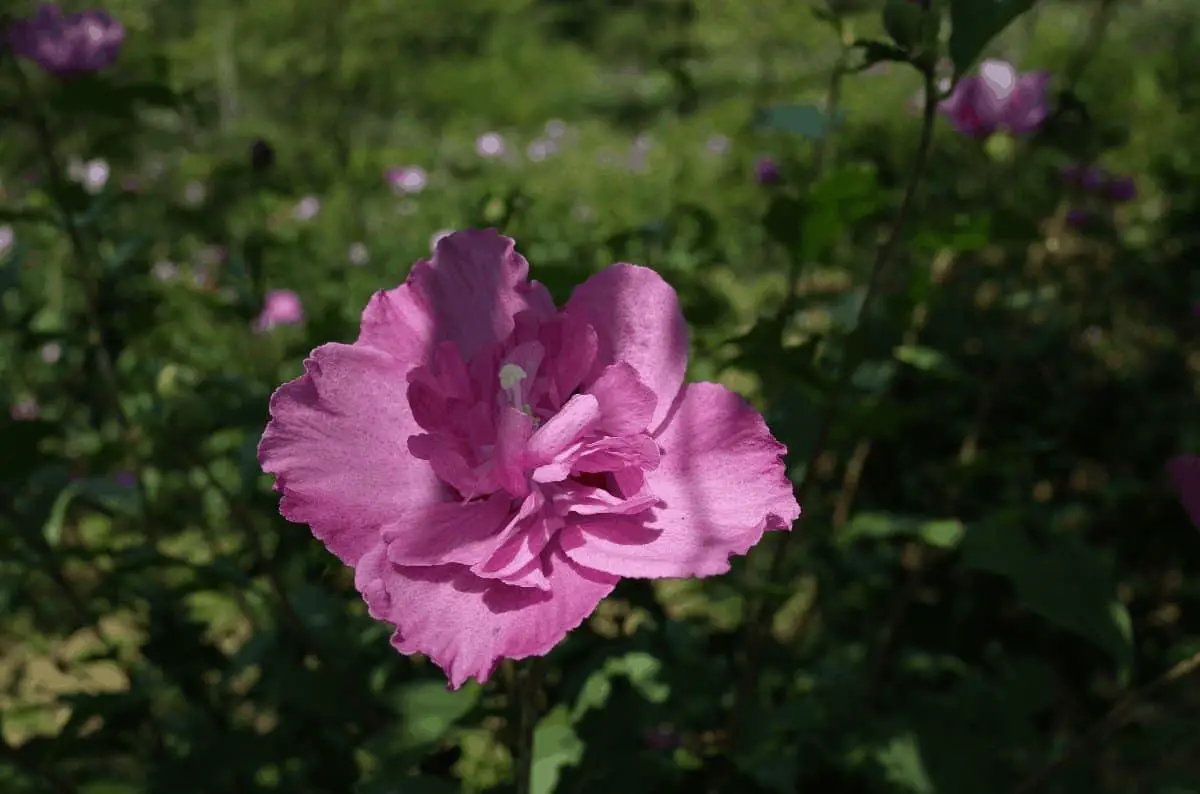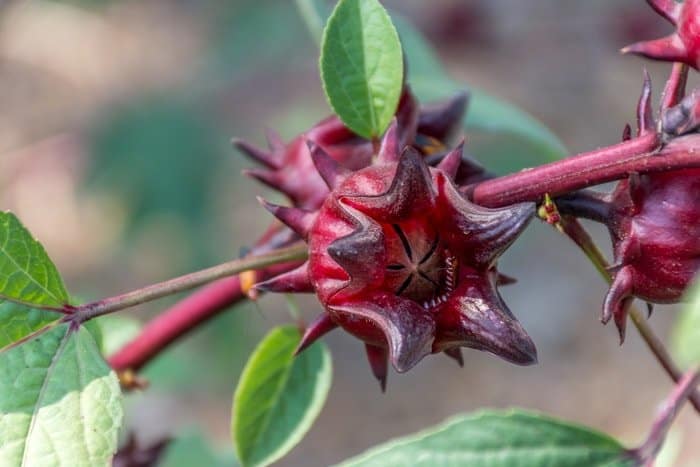Last Updated on February 22, 2023 by Tony Manhart
The Rose of Sharon has an interesting history, being neither a rose nor a specific flower. In many cultures, the term “Rose of Sharon” was used to describe a common flowering shrub. The name was taken from the Bible, where it appeared as a descriptor for an unknown plant. In the United States, the most common Rose of Sharon is the purple Hibiscus syriacus, a deciduous flowering shrub from East Asia. However, the term can also refer to the Hypericum calycinum or Hibiscus rosa-Sinensis. But, what is the best time to trim rose of Sharon?
The first step to determining when to trim your Rose of Sharon is to identify which plant you possess. Once you have this information, you can discover the best time to prune, make adjustments to the environment, and even deadhead when necessary.
Best Time to Trim Rose of Sharon: When to Trim Rose of Sharon
No matter what type of Rose of Sharon you possess, the flowers share some common qualities. It is important to give the flowering shrub plenty of moisture and to offer some protection from the hot midday sun. It grows best in USDA hardiness zones 5-9, meaning it prefers temperate climates with hot summers and cold winters.
The Rose of Sharon can stretch to 8 or 12 ft. in height and between 6 and 10 ft. in length, so pruning and trimming are essential to promote healthy growth and to stop the shrub from spreading out of control.
The Dormant Season
The best time to cut Rose of Sharon is during the dormant season. This dormant season occurs in late winter or early spring, typically around March. However, the shrub will thrive in trimmed at any point in the following months until early May.
Try to avoid cutting the shrubs when there is still a risk of significant snow or ice. The cold can damage freshly trimmed branches. Remove as much dead or damaged wood as you can, as these branches won’t be able to grow and can affect the overall health and appearance of your shrub.
If you are experiencing unusual weather, stick to the calendar. If you trim the Rose of Sharon too soon or too late, it is possible for the plant to experience plant shock. Plant shock is damage caused by sudden changes in the environment, and your flowers will be unable to grow and bloom properly once damaged.
Best Time to Trim Rose of Sharon: How to Trim Rose of Sharon
When it comes to the Rose of Sharon, determining how much to trim depends on how tall and wide you are willing to allow the shrub to grow.
If you have a finite amount of space, you will want to prune more frequently to avoid having branches and blooms in strange locations.
To prune properly, be sure to get a pair of gardening shears capable of cutting through the branches.
Trimming By Sections
Occasionally, you’re going to encounter a couple of natural characteristics in the Rose of Sharon that need to be eliminated for overall health and wellness. For example, if you come across crisscrossing or intersecting branches, it is best to eliminate at least one of them so growth occurs unimpeded.
You can use a pruning saw rather than shears, as these branches tend to be thicker than others and occur near the bottom of the shrub.
If you see any branches that are brittle, rotting, or colorless, get rid of those as well. If the issue is basic rotting or disease, cut to the point were the unhealthy portions end.
Rejuvenation Pruning
If the entire branch seems weak or discolored, cut the entire thing. Don’t worry about eliminating too much, as it is best to cut the Rose of Sharon back to 2/3 of its current size.
This practice is called hard or rejuvenation pruning and can be best for Rose of Sharon shrubs that have not grown well in the last two years.
When hard pruning, remember that you will likely grow fewer flowers, but they will be brighter and more vibrant because the plant can dedicate more resources to each bloom.
Pruning the New Growth
Finally, you should focus on pruning the new growth along the top. A major problem for the Rose of Sharon is its tendency to grow up before it grows out.
When poorly cared for, the Rose of Sharon can become extremely tall, making it difficult to treat and care for. When pruning, focus on eliminating branches that are longer than the rest and that stick out too much on the top. You can also get rid of branches and twigs on the sides to make a more pleasing shape.
Best Time to Trim Rose of Sharon: Should You Deadhead?
Although the Rose of Sharon is beautiful, a common problem gardeners complain about is the flower’s propensity for self-seeding. Because each shrub contains dozens of blooms, the Rose of Sharon is capable of propagating itself, sending its seedlings scattering throughout the yard. The result is a potentially invasive plant that starts to sprout in unexpected places, even in uncleaned gutters.
Deadheading Flowers
One of the ways you can avoid this trouble is by deadheading on a regular basis. The process of deadheading is when a gardener removes the blooms and seed pods of a plant after it has flowered and is starting to decline.
The seed pods of the Rose of Sharon can be found just underneath the blooms. You can literally snip the flowers off the plant once they have finished being beautiful. Make sure to get the developing seed pod, which emerges in October and takes between 6 and 14 weeks to mature.
Failing to eliminate the seed pods can result in imminent close propagation. The pods can drop their seeds to the soil directly below the Rose of Sharon, where they begin to grow. The result is clumps that work great as hedges but can be difficult for the average gardener to handle without fuss.
When do you plant Hibiscus syriacus?
Rose of Sharon plants and other hardy hibiscus varieties can be planted in spring or fall, as long as there is no danger of frost.
Plant perennial hibiscus plants in the spring so that they have an entire growing season to establish a good root system. A perennial hibiscus planted in the fall might not return as reliably the next spring as one planted earlier in the year. Plant rose of Sharon in spring or fall. The plants tend to leaf out a bit late in springtime, so don’t be alarmed if yours gets off to a slow start. Space the plants 6 to 10 feet apart; read the tag or label for the exact spacing.
Choose a site that gets full sun
They’ll grow in partial sun but not flower as well. Hibiscus prefers well-draining soil with plenty of organic matter, and neutral to slightly acidic soil. To avoid breakage of the long stems, plant hibiscus where they won’t be exposed to strong winds. As soon as the danger of frost is past in the spring, the indoor hibiscus can be placed outside on a deck or patio to enjoy its beauty all summer.
In the fall when night temperatures begin to drop, bring the hibiscus back inside again for enjoyment all winter. There are good reasons to keep them potted, such as being able to move them around, but we have also found that hibiscus do very well when planted in the ground in warm climates.
Protect the Rose of Sharon by applying a deep mulch of leaves around the base of the plant after the ground has frozen. It can also be protected from the wind by wrapping it loosely in burlap. Do not wrap tightly or cover the top and remove the wrapping at the end of winter.
Conclusion
The Rose of Sharon is a beautiful shrub with unique yellow, purple, white, or even pink flowers. Remember to only prune during the dormant season in late winter and early spring. Try to target unhealthy or long branches before trimming other sections of the plant. If you are struggling with trimming, switch from shears to a pruning saw, and focus on discoloration. Try to eliminate ⅓ of the plant for maximum benefit.
FAQ’s
FAQs
How do you prune rose of Sharon bushes?
In order to prune the rose in a healthy way, you will have to know their needs at different stages of their life cycle. They also require different types of nutrients and care throughout their lifespan.
There are three stages when it comes to pruning your rose:
- After transplanting or planting out
- When they flower
- When they fruit.
Can I cut rose of Sharon to the ground?
The answer to this question is no. The rose of Sharon is a perennial plant and cannot be cut down.
How far do rose of Sharon roots spread?
Rose of Sharon plants are able to spread their roots throughout the ground and are a popular ornamental plant in gardens. With this, they can be invasive too. This is why it is important to know how far they spread, how they grow and what makes them take root.
These shrubs have rhizomes that sprout roots very quickly when a root tip breaks off or a leaf falls on the soil. Their dense network of roots and rhizomes allow these plants to take over the area fast. They grow best in full sun and moderate moist conditions with soil that has good drainage.
Tony Manhart is a passionate gardener who has been tending to gardens for over 20 years. He takes pride in creating beautiful outdoor spaces with plants, trees, and shrubs that can thrive in any environment. He loves to share his knowledge with others and has taught classes on gardening basics and advanced techniques. He is committed to sustainability, using natural and organic methods to create and maintain gardens. He also works with local organizations to create green spaces for communities. When he’s not gardening, Tony enjoys hiking, reading, and spending time with his family.




